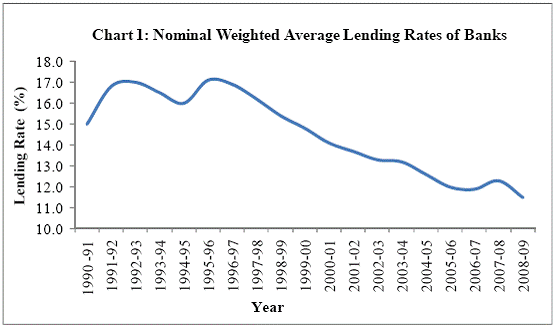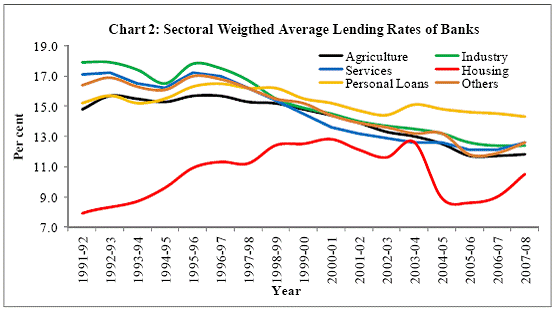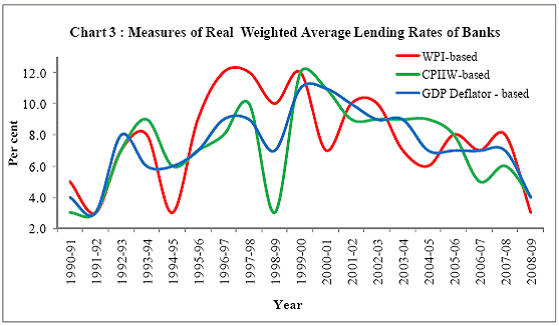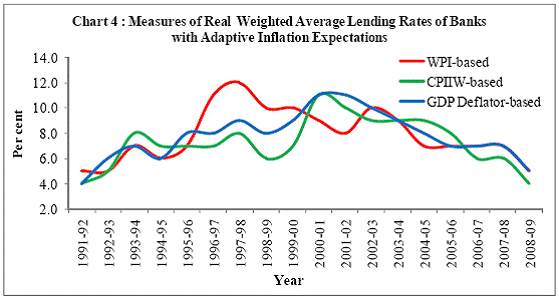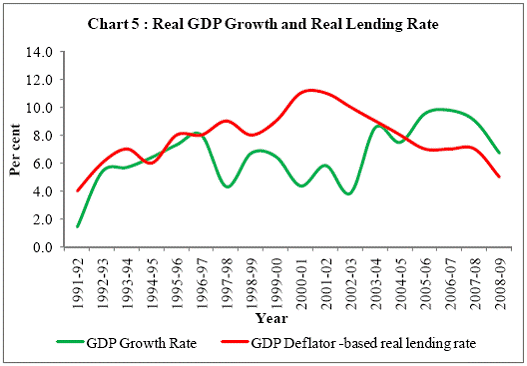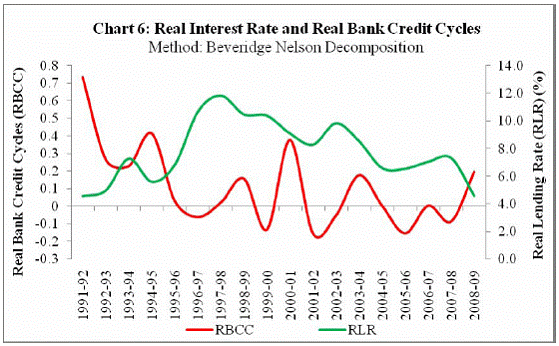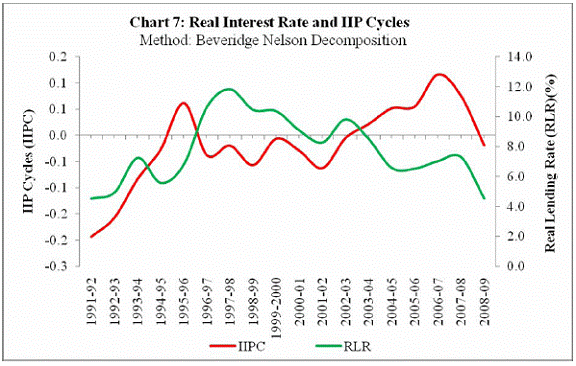 IST,
IST,


Perspectives on Lending Rates in India
Shri Deepak Mohanty, Executive Director, Reserve Bank of India
delivered-on జూన్ 11, 2010
Shri Dua, Shri Sen and friends. I thank the Bankers’ Club, Kolkata and Shri J.P. Dua, Chairman, Allahabad Bank for providing me the opportunity to speak to you this evening. As you know, banks will be switching over to a ‘base rate’ system of loan pricing from 1st July 2010. Besides the announcement of base rate, what is of greater significance is that it brings to fruition complete deregulation of rupee lending rates of banks, a process that began two decades ago. This is also a testimony to the maturity of the Indian banking system considering that earlier attempts at interest rate deregulation were not very successful. 2. What I propose to do is to briefly trace the process of lending rate deregulation and address a few issues that have arisen in the context of the base rate system. I will conclude with some observation about the relationship between inflation-adjusted real lending rate and credit growth and its implication for overall economic growth. I. Deregulation of Lending Rates 3. With the objective of providing credit to the productive sectors of the economy, bank lending rates as well as the allocation of bank credit were closely regulated by the Reserve Bank till the late 1980s. Furthermore, there were a number of sector-specific, programme-specific and purpose-specific credit stipulations. With the initiation of financial sector reforms in the early 1990s, various steps were taken to deregulate the lending rates of commercial banks. First, the credit limit size classes of scheduled commercial banks, on which administered rates were prescribed, were compressed into three slabs in April 1993. Second, a system of prime lending rate (PLR), the rate charged for the prime borrowers of the bank, was introduced in October 1994. The PLR system went through several modifications from a single PLR to multiple PLRs and then to a Benchmark PLR (BPLR) (Table 1).
4. Another important development during this time was the introduction of a ‘loan system’ of delivery of bank credit in April 1995. The objective was to bring about greater discipline in the utilisation of bank credit. Furthermore, the Reserve Bank relaxed the requirement of PLR being the floor rate for loans above Rs.2 lakh. Thus, in April 2001, commercial banks were allowed to lend at sub-PLR rates for loans above Rs.2 lakh. However, the divergence in PLRs and the widening of spreads for borrowers continued to persist. The PLRs turned out to be rigid and inflexible in relation to the overall direction of interest rates in the economy. In order to address these issues, a BPLR system was introduced in April 2003. 5. However, the BPLR system evolved in a manner that did not meet the objectives. Competition in an environment of excess liqidity had forced the pricing of a significant proportion of loans far out of alignment with BPLRs undermining its role as a reference rate. Furthermore, there was a growing public perception of under-pricing of credit for corporates and over-pricing of credit to agriculture as well as small and medium enterprises. Several requests were received by the Reserve Bank from banks suggesting a review of the BPLR system. 6. The lack of transparency in the BPLR system also hindered transmission of monetary policy signals. In view of the concerns pertaining to the shortcomings in the BPLR system raised by the public and those recognised by the Reserve Bank, the Annual Policy Statement for 2009-10 announced the constitution of a Working Group on BPLR to review the BPLR system and suggest changes to make credit pricing more transparent. On the basis of the recommendations of the Working Group (Chairman: Deepak Mohanty) and after taking into account the views of various stakeholders and discussions with banks final guidelines on the base rate system were announced on April 9, 2010. II. The Base Rate System 7. The base rate system will replace the BPLR system with effect from 1st July 2010. Base rate shall include all those elements of the lending rates that are common across all categories of borrowers. Banks may choose any benchmark to arrive at the base rate for a specific tenor that may be disclosed transparently. Banks are free to use any other methodology, provided it is consistent, and is made available for supervisory review. Banks will determine their actual lending rates on loans with reference to the base rate and by including such other customer specific charges as considered appropriate. 8. With the introduction of the base rate system, all categories of loans will be priced only with reference to the base rate with a few exceptions. The base rate can also serve as the reference benchmark rate for floating rate loan products, apart from other external market benchmark rates. The floating interest rate based on external benchmarks should, however, be equal to or above the base rate at the time of sanction or renewal. 9. Since the base rate will be the minimum rate for all loans, the current stipulation of BPLR as the ceiling rate for loans up to Rs.200,000 is withdrawn. It is expected that this will increase the credit flow to small borrowers at reasonable rates and direct bank finance will provide effective competition to other forms of high cost credit. The interest rate on rupee export credit has also been deregulated. 10. Keeping in view the largely retail deposit-based banking in India, there is a need for a benchmark for transparent pricing of loans. Even in wholesale fund- based banking systems, the London Interbank Offered Rate (LIBOR) is widely used as a benchmark which is essentially an interbank deposit rate. Thus, the base rate fulfills the requirement of a benchmark while giving full flexibility to banks with regards to its computation and overall loan pricing. III. Lending Rates in India 11. Let me now turn to an analysis of lending rates in India. The movements in nominal weighted average lending rate2 for the banking industry as a whole has shown a gradual decline. It has come down from a range of 16-17 per cent in most part of the 1990s to about 11.5 per cent by 2008-09. The declining trend is clearly visible in the 2000s (Chart 1). However, wide dispersion persists in actual lending rates owing to substantial sub-BPLR lending.
12. How does one explain the trend in the lending rates? First, at a fundamental level the decline in the inflation rate between the 1990s and 2000s contributed to lower nominal lending rates3. Second, lower inflation volatility in the 2000s reduced the inflation risk premia. Third, significant productivity improvement in the banking system lowered the intermediation cost (Table 2). Fourth, the observed decline in weighted average lending rates in the banking system can be attributed to the improvements in pricing of risk due to the increased space provided by progressive deregulation of lending rates.
13. While the lending rates of various categories of borrowers depend on the risk and reward perceptions, the rates have declined for most categories of borrowers over time. At a disaggregated level, the weighted average lending rate for personal loans was higher while it was the lower for housing loans (Chart 2).
IV. Real Lending Rates 14. From the perspective of borrowers as also from the point of view of sustainability of debt, what matters is the real interest rate. The Fisher equation gives the relationship between the real and nominal interest rates4. In the Fisher hypothesis time preferences of the public and technological constraints determining the return on real investment which is assumed to be constant5. So the nominal rate moves with inflation. The Fisher equation can be used in either ex ante (before) or ex post (after) sense. As ex ante inflation is not observable, one could compute the ‘expectations augmented Fisher equation’ given the desired real rate of return and an expected rate of inflation over the period of a loan. While there is no unique way to compute expected inflation, the real interest rate ex post can be computed as nominal interest rate minus realized inflation rate.15. As investment decisions are made over a medium-term horizon, it is important to consider real lending rates in a medium-term perspective. Borrowers tend to view the nominal lending rate in terms of a desired real rate of return and expected inflation. Although several methods, including surveys, are employed to calculate expected inflation, it is difficult to assign expected values with a reasonable degree of precision given the uncertainty surrounding the future outcomes. This is more pertinent to developing economies like ours which are subject to structural economic factors and unanticipated supply shocks. 16. Another useful way to address this issue is to derive expectations by smoothing the inflation series. This presupposes that expectations are adaptive6 which is often the case in economies and markets with asymmetric information. Furthermore, given monetary policy credibility, the underlying inflation expectations are generally stable but for the deviations caused by short term volatility due to transitory factors7. 17. In our context, computation of real interest rate, even in an ex post sense, becomes challenging because of lack of a comprehensive measure of consumer price inflation. Hence, I show here three alternative ex post measures of real lending rates based on: (i) the wholesale price index, which is our headline measure of inflation; (ii) the GDP deflator, the most comprehensive measure of inflation; and (iii) the consumer price index for industrial worker (CPIIW), which is the most representative of consumer price indices. It can be seen that the alternative measures of real interest rates have moved in tandem though there have been significant year to year variations (Chart 3).
18. If one assumes the inflation expectations to be adaptive then one could consider taking a larger time frame for economic agents’ memory than just pertaining to the immediate time interval. Here I have taken a two-year moving average series of inflation rate to represent adaptive inflation expectations and for estimating ex post real lending rates. The smoothed real lending rate series reinforces our earlier observation that lending rates rose in the 1990s and declined during the 2000s (Chart 4).
V. Credit Growth and Real Lending Rates 19. Now I turn to the relationship between real GDP growth and real lending rates. Technically, the real GDP growth is a measure of average real rate of return in the economy. Ideally, the real lending rates should not be too much out of alignment with the real GDP growth rate. The data for the period 1990-91 to 2008-09 show that real lending rates were higher than real GDP growth particularly during 1997-98 to 2002-038. This scenario has clearly changed since 2003-04 concurrent with the high growth phase of the Indian economy. The weighted average real lending rate has since remained below the real GDP growth rate (Chart 5).
20. From a business cycle perspective, one could examine relationship between real interest rate and credit growth. The assessment of real lending rate in the context of underlying credit cycles can potentially throw light on aspects of cyclicality in economic activity and its relationship with financial sector dynamics. High (low) real interest rates coincide with low (high) credit growth (Chart 6).
21. In terms of real sector activity, approximated by the index of industrial production (IIP), the industrial growth cycles are also inversely related to the real interest rate cycles (Chart 7).
22. The base rate will prompt banks to make a better assessment of risk in pricing of loans. It is expected to be more responsive to the stance of monetary policy which should facilitate movement in effective real lending rates consistent with the rates of return in the economy. Conclusions 23. Let me conclude now. First, the introduction of the base rate system along side removal of interest rate ceiling on small loans and freeing of rupee export credit interest rate brings to fruition over two decades of efforts to deregulate the lending rates of banks. This is expected to enhance the allocative efficiency of the financial intermediation process by banks. Second, deregulation of lending rates will promote financial inclusion with greater credit flow to agriculture and small business. This, together with other specific measures taken by the Reserve Bank for financial inclusion, will draw borrowers away from the informal financial sector to the formal financial sector and thus, facilitate credit penetration. Third, the base rate system that comes into effect from 1st July 2010 gives complete freedom to banks in their loan pricing decisions while ensuring transparency. Banks have unlimited access to public deposits and privileged access to the liquidity facility of the Reserve Bank. Hence there is a greater need for transparency and responsible lending practices for public purposes. Fourth, the base rates of banks will mirror their relative efficiency and cost structure. While lending rates tend to be sticky, it is expected that the base rate system will show greater flexibility and strengthen both the interest rate and credit channels of monetary transmission. Fifth, the new system gives the freedom to banks to choose other market related benchmarks besides their base rates for pricing floating rate products. This could promote development of market benchmarks. It could also deepen the money market to facilitate short-term liquidity management by banks. Sixth, there is some apprehension that the base rate system may raise the effective cost of borrowings. This is unlikely because corporates have access to multiple sources of funds and hence the effective borrowing rates will be determined by market competition. Seventh, the nominal effective lending rate of the banking system which remained higher in the 1990s have declined significantly in the 2000s. This can largely be attributed to moderation in overall inflation, reduction in inflation risk premia, interest rate deregulation and increasing efficiency of the banking system. Eighth, the computation of real lending rate becomes challenging without a comprehensive measure of consumer price inflation and difficulties in measuring inflation expectations. Nevertheless, ex post measures of real lending rates over the last two decades show a clear pattern. The real lending rates rose in the 1990s and then declined in the 2000s. The real weighted average lending rate was higher than the real GDP growth rate, particularly during the period 1997-98 to 2002-03. Thereafter, the real weighted average lending rate has declined concurrent with the high growth phase of the Indian economy. Finally, credit and industrial output cycles show inverse relationship with real interest rate. However, there is a need for further research to better understand the relationship between credit and interest rate cycles and its implications for sustainable growth. 1 Speech by Deepak Mohanty, Executive Director, Reserve Bank of India, delivered at the Bankers’ Club, Kolkata on 11th June 2010. The assistance provided by Dr.Himanshu Joshi, Shri S. Gangadharan and Shri Dhirendra Gajbhiye is acknowledged. 2 It has been worked out by using account level data for advances as at end-March each year as reported in Basic Statistical Returns (BSR) 1A. 3 The annual average WPI inflation declined from 8.1 per cent in the 1990s to 5.3 per cent in the 2000s. Similarly CPI inflation declined from 9.5 per cent to 5.5 per cent. 4 i = r +p; where ‘i’ is nominal interest rate, ‘r’ is real interest rate and ‘p’ is the inflation rate. 5 Fisher, Irving (1930), The Theory of Interest, (New York: Macmillan). 6 Backward looking. 7 India is a moderate inflation country with the long-term average inflation of about 7.5 per cent which has come down to around 5 per cent in the recent years. Hence the long-term inflation expectations can be assumed to be stable. 8 Analysing the data for 1990-91 to 2001-02, Dr. Rakesh Mohan, former Deputy Governor had observed, "effective real lending rate continues to remain high … which has adverse systemic implications". Valedictory address at the Bank Economists' Conference 2002, at Bangalore, December 29, 2002 |
||||||||||||||||||||||||||||||||||||||||
పేజీ చివరిగా అప్డేట్ చేయబడిన తేదీ:






